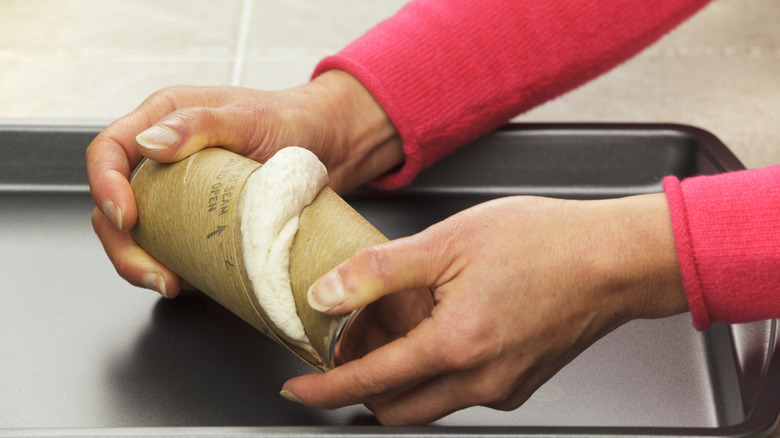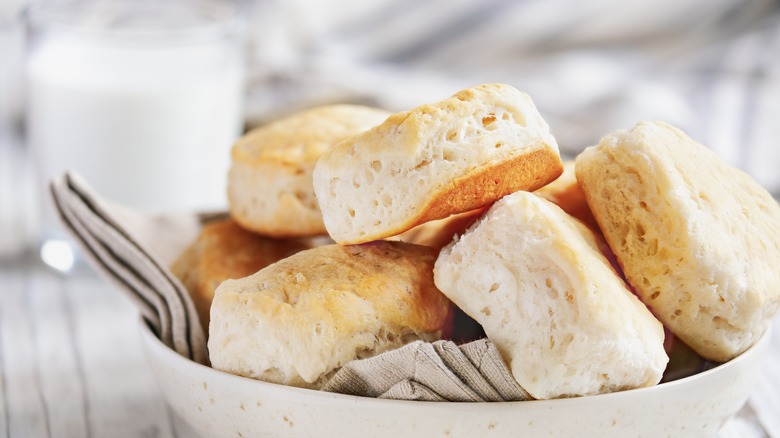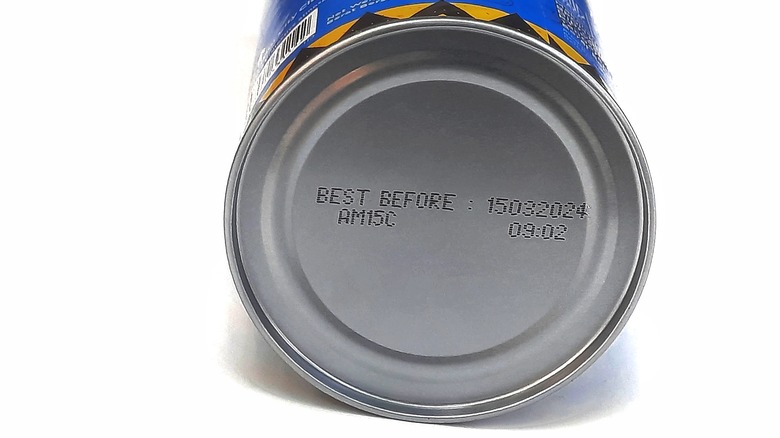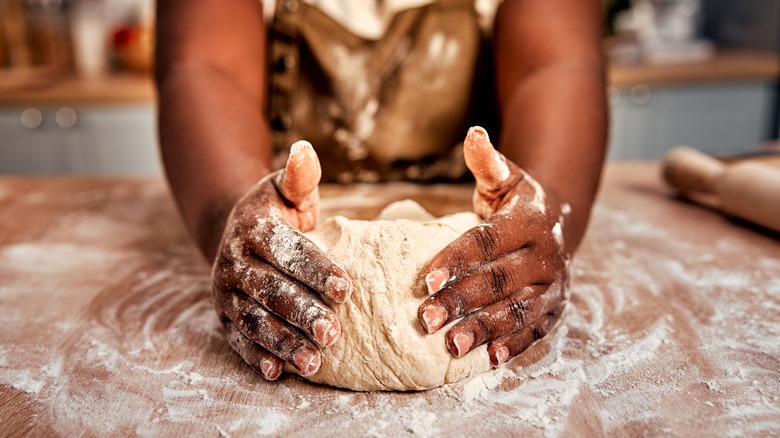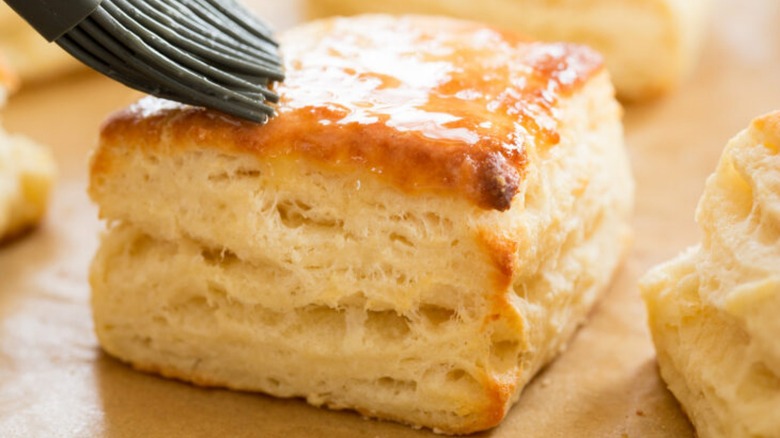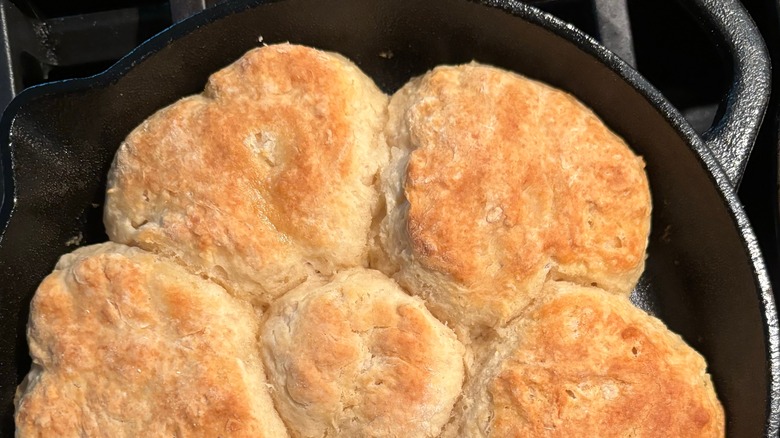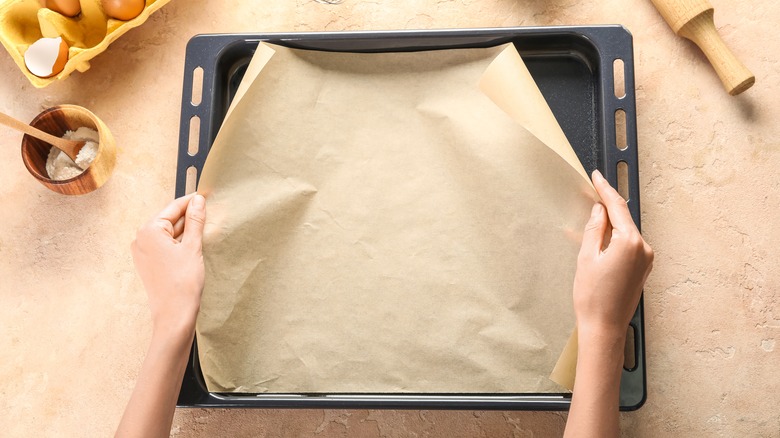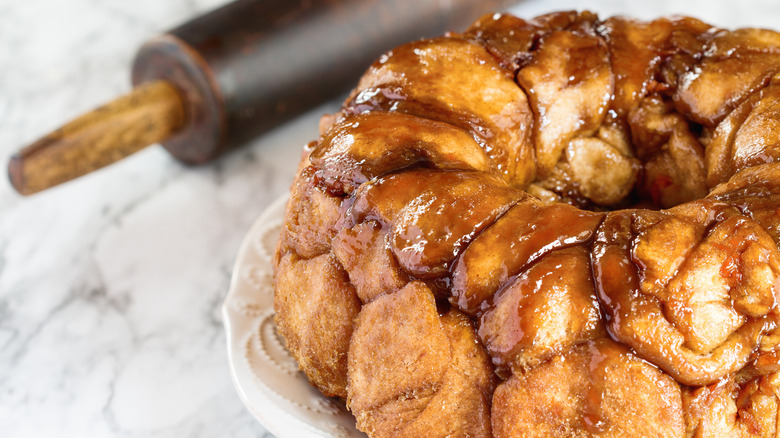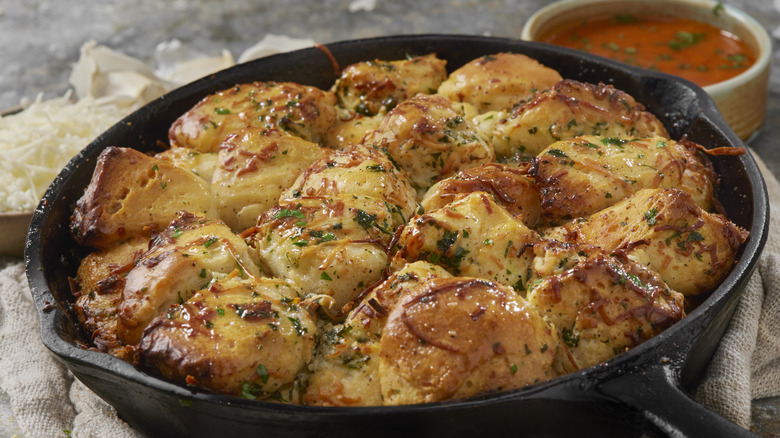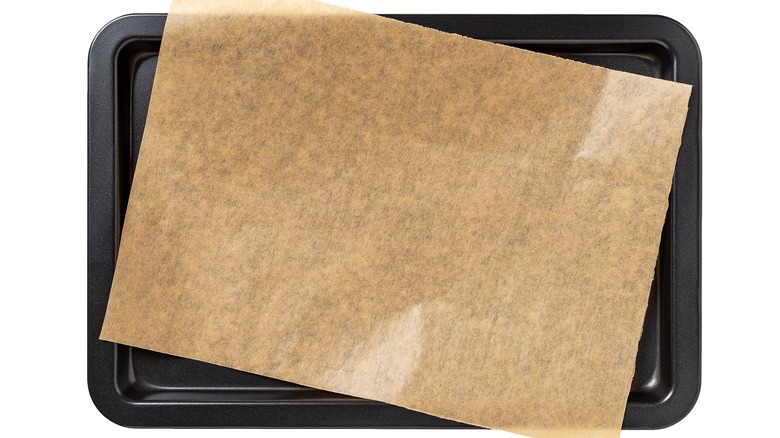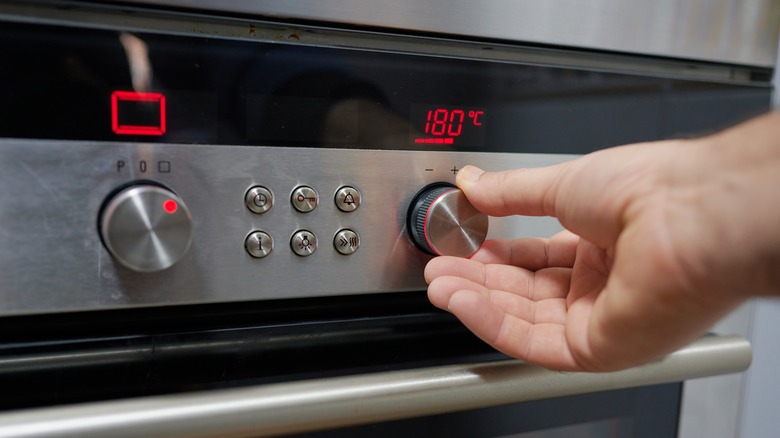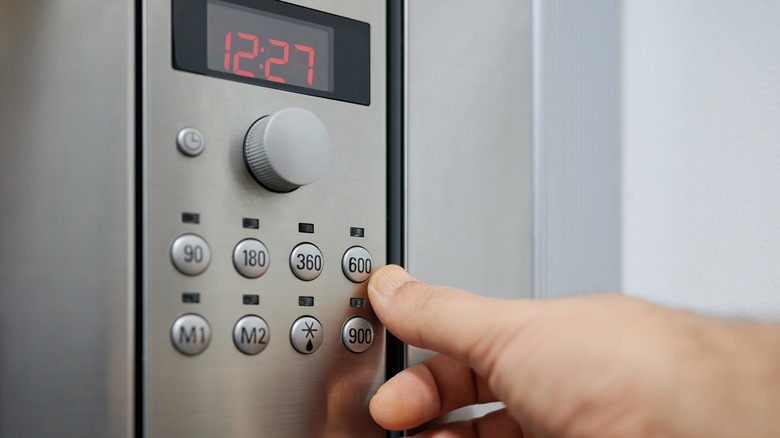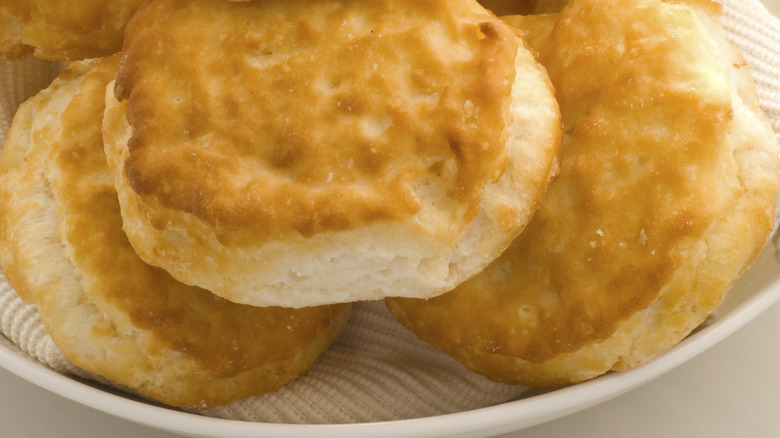12 Mistakes Everyone Makes With Canned Biscuits
Nothing beats a delicious, buttery, fluffy golden biscuit. Biscuits, no matter the type, are so much more than a starter carelessly thrown in a bread basket. They can be elevated to a fancy bite-sized appetizer and easily become the perfect vessel for gravy or a delectable sweet treat. And while we all especially love homemade biscuits, the reality is that sometimes time isn't on our side. In these cases, canned biscuits are the perfect solution. However, it's not all easy going. According to the group of baking experts we spoke to, there are some mistakes you want to avoid in order to allow your biscuits to live up to their full potential.
Amy Jam, co-owner of Bread Bros in California said that avoiding these mistakes translates to other baking techniques, too. "This advice works wonders for all your canned baking delights and, while I'm not often consuming canned baking goods, they can serve a purpose and can be tasty when done right," she said.
Our experts weighed in on 12 mistakes they see home chefs make when using canned biscuits. These range from selecting the right type of biscuit to following baking instructions, to reheating and storing properly. Avoid these, and you could reach biscuit glory even when you're tight on time.
Selecting the wrong biscuit type
The first choice you want to get right when cooking with canned biscuits is that you have picked the right fit for your dish. Big brands you would find at your grocery store typically have biscuit options with different flavors or textures like Southern style, buttermilk, or flaky, to name a few.
"Classic buttermilk biscuits are a staple and super versatile," said Imene Senouci (Imsen) of Ambitious Foodie. "They have a rich, buttery flavor and a light, fluffy texture. Perfect for breakfast sandwiches, biscuits and gravy, or just slathering with butter and jam." You may also notice a more tangy taste than what you detect in other biscuit recipes due to the buttermilk. Another common canned biscuit choice are hearty Southern-style biscuits, known for being denser than other varieties. "They're fantastic for more substantial meals, like topping a pot pie or serving alongside a hearty stew," Senouci said.
Many people swear by a particular biscuit brand, as not all brands may be up to the same level of quality. The brand may also be important if you are looking for organic biscuits without artificial ingredients. "Annie's offers a great organic biscuit with really easy directions to follow. And you can never go wrong with organic ingredients," said Lindsay Sears-McDonald, owner and baker of All About The Cinnamon in Los Angeles. There are even canned biscuit options for those with gluten sensitivities. "Brands like Pillsbury offer gluten-free options that are pretty tasty and have a good texture," Senouci said.
Using biscuits past expiration date
If you found your can of biscuits at the back of your fridge, be sure to check the expiration date before cracking it open. While that may sound like an obvious rule of thumb, our experts say that it's one that can be all too easy to overlook. "Using expired biscuits can affect the taste and texture. Fresh is best, so keep an eye on those dates!" Senouci urged.
While your biscuits may still be okay to eat from a food safety perspective, the various dates listed on your packaging typically refer to when you can expect changes in the product quality. A "Best If Used By" date shows the best product quality or flavor, while the "Sell By" date is guidance from manufacturers for retailers to remove the products from shelves in order to maintain a consistent level of quality. The "Use By" date also doesn't serve as a safety warning, with some exceptions; instead, it also guides you to when a product will be at the best quality.
So if you want the best quality biscuits coming out of your can, avoid using them past that expiration date. If you do decide to use expired canned biscuits, be sure there are no signs of spoiling like discoloration, mold, off odors, or issues with texture. Another bad sign: your can is bloated or doesn't appear to be intact. Be sure to discard those biscuits immediately, as that can be a sign of bacterial contamination.
Overworking the dough
Many times, biscuits are already pre-sectioned or pre-cut to make it easy to rip and stick them on the baking sheet quickly. However, if you find yourself needing to shape the dough more with your hands, use caution. "Don't overwork the dough! When you do, your biscuits end up tough, and who likes that?" Jam said. "Simply take the dough straight from the can, position it on your baking sheet, and pop it in the oven. Easy does it!"
But why work with canned biscuit dough in the first place if all the hard work is supposedly done for you? Some recipes use canned biscuit dough as a base for more complex dishes, requiring you to reshape them for something like monkey bread. If this is your situation, Senouci recommends handling the dough, "as little as possible. Overworking it can make the biscuits tough instead of light and fluffy." That's because too much handling can produce too much gluten and create an unpleasantly chewy dough.
If you roll out your biscuit dough into one uniform large piece, you can use biscuit cutters to shape your own biscuits (and don't forget to stop throwing away those scraps). That way, you're working less directly with the dough and are less likely to roll out your dough again and inadvertently overwork it.
Not upgrading your biscuits with add-ons
If you feel like your canned biscuits are a little underwhelming, our experts have some inspiration. Biscuits are a great blank canvas that's open to fun additions. The added touch can be as simple as spreading some butter or herbs, or by stuffing your biscuits with a fun filling. "For that extra touch of yum, don't forget to brush your biscuits with melted butter before baking. It gives them a beautiful golden color and a delicious flavor boost," said Senouci. "You can even sprinkle a little garlic powder or herbs for a savory twist!"
You can also go big by stuffing your biscuits with cheese. To do this, separate your biscuit layers and put cheese in between. You can also utilize muffin tins to keep the ingredients from seeping out of the sides. Add in ham with your cheese to make it a protein-packed pocket.
Whatever you decide to add to your biscuits, do so carefully. "If you're feeling adventurous and want to spice things up with some cheese or herbs, remember to fold them in gently," said Jam. "Rough handling is a quick way to ruin the delicate texture we all love in biscuits, and canned biscuits are especially vulnerable to this."
Overcrowding the pan
Putting too many biscuits onto a baking sheet or pan overcrowds them. You may end up with one giant, unattractive, undercooked (and inedible) mess. Sears-McDonald said the most common problem is not knowing when your biscuits are cooked appropriately. She noted that an underbaked biscuit is raw and an overbaked biscuit is dense and not fluffy.
"Overcrowding can lead to biscuits sticking together and not cooking evenly," Senouci said. "Give them some space to puff up and get that lovely golden brown all over."
How do you know if you are overcrowding your biscuits? Jam says it is as simple as following the instructions on the package to evenly space your biscuits on your baking sheet. "That little bit of room will make sure each one cooks up nice and even, which ends up in perfectly fluffy biscuits every time," she said.
However, there are situations where crowding the pan may actually be to your benefit. If you struggle with getting your biscuits to rise tall, try placing them close together in a cast-iron skillet or pan. Don't place them together too closely, but having your biscuits just barely touching, combined with the higher walls of a cast-iron skillet, may keep them from spreading out.
Not using baking sheet or pan liner
Extreme sticking on the pan can ruin a dish, especially biscuits. Using a spatula to get them off the pan can result in the bottom layer getting left behind (and a lot of scrubbing later). Luckily, there are ways to avoid that mess. "Whether it's parchment paper or a silicone baking mat, using a liner on your baking sheet helps prevent sticking and makes cleanup a breeze," said Senouci. "Plus, it can help with even browning on the bottom of your biscuits."
You can typically find parchment paper at the grocery store. This silicon-infused paper can be the perfect non-stick agent to allow your biscuits to get golden brown and come up easily with the help of a spatula. Parchment paper also helps maintain a more regular temperature and battles those tough hot spots on your baking sheet.
If you decide to opt for a reusable silicone baking mat, there are plenty of options out there. Just be sure to take care of your mat properly, including cleaning it the best way, and take a minute before using to ensure that there are no tears or cuts. Also, it's always smart to read the mat's package to ensure your mat is able to handle the temperature required for your biscuits.
Not using biscuits for dessert
When you think of biscuits, you may not automatically think of dessert. But canned biscuits don't necessarily have to be savory. They actually be your head start to making a sweet treat without rolling out pastry dough or making your own dough from scratch. For instance, with a can of dough, you already have the base for recipes like pull-apart monkey bread. If you get some cutters and mix up some cinnamon sugar, you've got yourself halfway to a donut. "Cut the biscuits into doughnut shapes using a small cutter," said Senouci. "Fry them in hot oil until golden brown, then toss in cinnamon sugar for a quick and easy doughnut fix."
Add fruit filling in between sheets of precut biscuits and you have mini pies. You can also use biscuit scraps that are already baked to make a biscuit bread pudding. Meanwhile, shortcake is technically considered a biscuit, so repurpose your canned biscuits to make an homage to a traditional strawberry shortcake. With some creativity and an open mind, the options are practically endless!
Not using biscuits for quick meal ideas
Not only are biscuits great for dessert, but they can be the base of a whole meal! "I've found that canned biscuits are incredibly versatile in the kitchen, and can be used for everything from dumplings in soup to the perfect base for homemade cinnamon rolls. If you're putting together a quick breakfast sandwich, a canned biscuit could add just the right touch," said Jam.
Hearty favorites like a classic chicken and dumplings recipe or a variety of warming pot pie recipes can be made all the easier with the use of canned biscuit dough. "Use the biscuits as a quick crust for a pot pie. Fill a baking dish with cooked chicken, mixed vegetables, and creamy sauce, then top with biscuits. Bake until the biscuits are golden brown and the filling is bubbly," Senouci said. Biscuits can elevate your breakfast sandwiches
There are also fun ways to utilize any leftover biscuit scraps that may not have made it from the can in the best shape. Throw the scraps in a soup to make a quick version of soup dumplings, for instance, or twist them up and brush with butter to make little biscuit sticks that you can then bake. Or, consider baking up the leftover bits biscuit dough to make croutons and dress up a salad.
Using the wrong cookware to bake your biscuits
Even if you follow the instructions on the biscuit can to the letter, your results can be dramatically skewed by your cookware choice. For canned biscuits, a nonstick baking sheet is usually sufficient. Senouci suggested a light-colored, non-insulated baking sheet for the purpose. "Dark or insulated baking sheets can cause the bottoms of the biscuits to brown too quickly or even burn," she warned.
If you opt for a darker baking sheet, lower your oven temperature by 25 degrees and decrease your baking time by around four minutes. Darker metal pans absorb and spread heat more efficiently, meaning less cooking time and heat is necessary. This can be an asset for dishes you want to get crisp, but if you're worried about your biscuits getting burned, line your dark baking sheet with parchment paper to act as an insulator.
If you don't have a non-stick baking sheet, a cast-iron skillet is also a potentially good option. "To get that delightful light crust, you should use a light-colored non-stick baking sheet or even a cast iron skillet," said Jam. "This helps keep the tops of the biscuits tender and flaky." Frying up stovetop biscuits with a cast-iron skillet and some butter can help to give you a caramelized crust and can be even quicker (to the tune of just 15 minutes) than going through the oven preheating and baking process. Sears-McDonald also suggested a 9-inch by 13-inch casserole dish for biscuit recipes.
Not preheating your oven
You might be anxious to get your dough in the oven, but don't let them sit around inside the device while it's preheating. "Always, and I mean always, preheat your oven, as the can suggests," Jam said. And for maximum accuracy, get set up with the right thermometer, just like chef Andrew Zimmern recommends. "To avoid any guesswork, use an oven thermometer to make sure you're spot on with the temperature."
Why exactly is preheating so important? This step gets the oven warmed up and allows your biscuits to cook properly (and fully) for the entire baking time. "Starting in a cold oven can result in uneven baking, and nobody wants biscuits that are doughy on the inside and overcooked on the outside," said Senouci.
But the oven doesn't necessarily have to stay empty during preheating. Another trick to getting your biscuits just right is to also preheat your pan. "For perfectly textured biscuits that brown evenly, pop your baking sheet in the oven to heat up before you bake them," Jam said.
Reheating leftover biscuits in microwave
Having biscuit leftovers is a delightful treat. However, if you reheat your biscuits incorrectly, you're unlikely to enjoy them as much the second time around. It can be tempting to pop them in a microwave for an easy process, but you will lose that crisp golden crust. Instead, rewarm them in the oven or a toaster oven.
"When you're ready to bring those biscuits back to life, wrap them in foil and reheat them in a 350-degree Fahrenheit oven for about 10 minutes," said Jam. "They'll come out just right, and it'll feel like they were baked fresh all over again!" The foil is key, as lightly covering your biscuits will prevent them from drying out, according to Senouci. You can also brush your biscuits with butter to keep them moist.
If you don't want to heat up your oven (and your whole house), a toaster oven can be sufficient for reheating and even baking your biscuits raw. A toaster oven is often more energy efficient than its full-size counterpart and heats up faster. But if you are in a pinch and your microwave is your only option, then at least wrap your biscuit in a damp paper towel and reheat in increments of 15 seconds or less until your biscuit is the desired temperature.
Storing leftover biscuits improperly
If you end up with leftovers, that is great! But if you want to enjoy your biscuits later, be sure to store them properly. If you plan on eating your biscuits sooner rather than later, Jam recommends putting them in an airtight container and keeping them at room temperature for a couple of days.
For longer-term storage options, cool your biscuits completely on a wire rack, then wrap them tightly with aluminum foil or in freezer bags. This will keep your biscuits from drying out. If using bags, be sure to get all air out before sealing. Biscuits typically should keep one week in the fridge and up to three months in the freezer. After those three months, your frozen biscuits should still be safe to eat but may not be the same quality as when they were first baked.
As for enjoying those frozen biscuits, it's best to get your oven going yet again. However, it is a simple process. "When ready to reheat, temp your oven to 300 and bake for 15 minutes," Sears-McDonald said.
